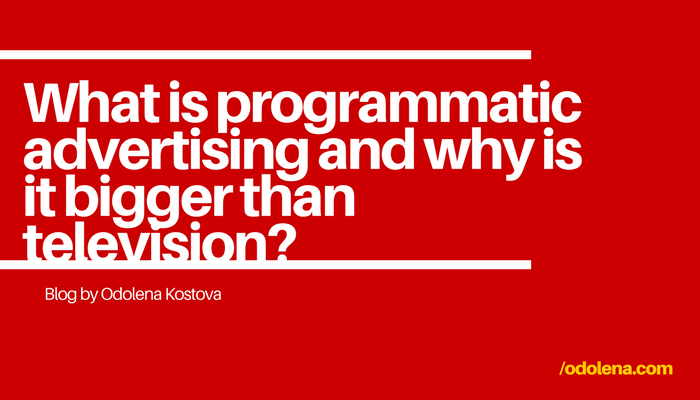What is programmatic advertising and why is it bigger than television?
If you have anything to do with marketing and advertising you must have heard the term programmatic. Usually mentioned by someone who is not entirely sure what it means. Some say programmatic is like sex – a lot of people are talking about it, but few are doing it and even fewer actually good at doing it.
So, what is it?
“Programmatic” ad buying typically refers to the use of software to purchase digital advertising, instead of the traditional process that involves human negotiations. It’s using machines to buy ads, basically.
Before Programmatic advertising the process of ad selling and buying was done manually by cold calling, negotiations and meetings. You can compare it to calling a newspaper to place your ad there. With the expansion of the internet in the early 2000s the number of websites with a lot of traffic started to increase and the behaviour of users started to become less predictable. The whole process of people negotiating every single ad space became bureaucratic and inefficient. Therefore, it was replaced by machines.
How does programmatic advertising work?
Imagine you are a website owner with thousands of users on your website every day. You decide to sell an ad space to a business. We call this “placement”. However, this means that for the negotiated amount of time this placement is taken by just one business. No matter what kind of people see the website they will all be presented to the same ad. This does not suit you and does not suit the business.
One of the most common programmatic brokers is Google AdSense which works with Google AdWords. The advertiser places an ad on Google AdWords and sets the requirements for their audience – demography, interests, country of residence. Then whenever someone who is in this selected audience bucket hits a website which allows AdSense there is an auction between all the advertisers who are targeting the same audience on the same placement.
This is called a real-time auction. There is another way which is buying a guaranteed amount of impressions (times your ad has been shown to a unique user). This is referred as "programmatic direct".
As everyone else is bidding per click or per thousand impressions the system considers the bids, the click through rate (ratio between the people who saw an ad and who clicked on it) history and audience settings of the bidders and selects to generate the ad which matches as closely as possible the requirements. Therefore, different people see different ads on the same websites. Their search and browsing history helps Google to put them into consumer categories, demographic groups and lists. Theoretically the ads we see must be very relevant to what we are interested in.
Unlike a TV or a newspaper ad when all users are forced to watch the same thing at the same time, programmatic advertising is placing the content a user is most likely to be interested in. This is a very complicated and fully automated process which is happening in milliseconds before a webpage loads.
The future.
In 2018, Digital Advertising’s market share is predicted to exceed TV advertising’s share for a first time in history. What does this mean for advertisers? People with digital marketing skills will be in higher and higher demand. The good news is that digital marketing knowledge is available at low cost or even for free. You can sign up for my free digital marketing course. The content is suitable for beginners and more than 2000 happy students from all over the world enrolled already.
About me: I am an experienced digital marketing professional who started her career at Google as a digital marketing consultant for over 100 SMEs. Grab a FREE e-book from my website. I am a full-time PPC manager at Hult International Business School and part-time blogger. Follow on Instagram and Twitter @odolena
